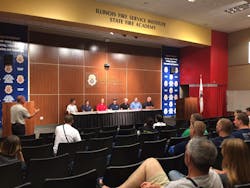Research Participants Join Efforts to Improve Firefighter Health
CHAMPAIGN, ILL. – While Illinois Firefighter/Paramedic Justin McWilliams knows he’s thrust into "toxic soup" when he does his job, he’s also anxious to learn how to protect himself.
That’s why he and 11 other firefighters rolled up their sleeves, gave blood and wore a number of monitors while they participated in a number of scenarios at the Illinois Fire Service Institute (IFSI).
“This has been an exciting month,” said Dr. Gavin Horn, IFSI director of research. “This is the first opportunity to work together.”
Among the partners in the project with IFSI are NIOSH, UL, University of Illinois, Chicago, and Skidmore College.
NIOSH technicians used delicate instruments to determine the gases and contaminants emitted as home furnishings burned. Swabs of firefighters’ skin and body were collected before and after the evolution.
To make sure the crews started with the same baseline, they donned new gear donated by Globe, considered a partner in the project.
IAFF officials said they’re looking forward to seeing the data.
“It was interesting to watch it. We all know it’s a dangerous job, and we’re exposed to many cancer-causing chemicals,” said Pat Morrison, IAFF.
Regardless, Morrison said the message about hidden dangers needs to be shared. Firefighters need to take the time to protect not only themselves, but their families as well. Gone are the days of doing things ‘the way we’ve always done them.’
He added that 60 percent of the firefighters who will be added to their memorial this year in Colorado were victims of cancer.
Research results will give fire officials ammunition when they approach legislators about changing laws.
In the small apartment-type structure used for the study, the beds were topped with polyurethane mattresses as well as bedspreads containing a number of chemicals. Devices captured samples of particles in the air before, during and after the fire.
Firefighters involved in the study thus far have all been career or part-time, and have completed a physical.
UL Firefighter Safety Research Director Steve Kerber said he was pleased his team had the opportunity to participate. In addition to collecting air, heat and other samples, the team also tested which gear washing method was best. Among those tried were a dry brush and wet brush with detergent.
He noted that things occurred that they hadn’t anticipated. “It was a tremendous opportunity for us.”
Dr. Denise Smith said she’s anxious to examine the statistics gathered to determine what firefighting activity does to the body.
She mentioned that one firefighter’s temperature during overhaul reached 103. “We need to know when our crews are ready to be placed back in service.”
Blood pressures were monitored until 10 p.m. Monday. The special cuff measured the aortic pressure.
